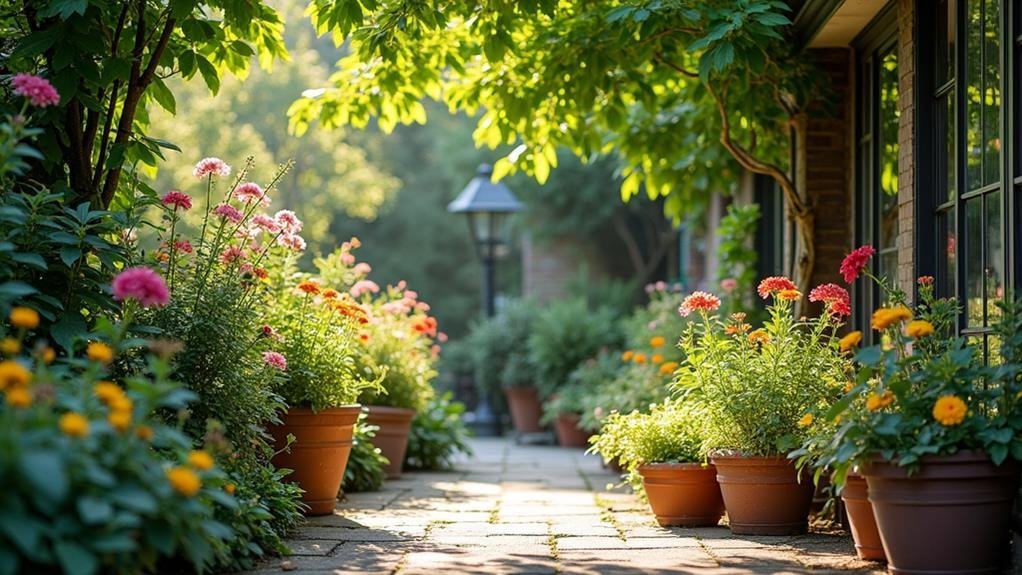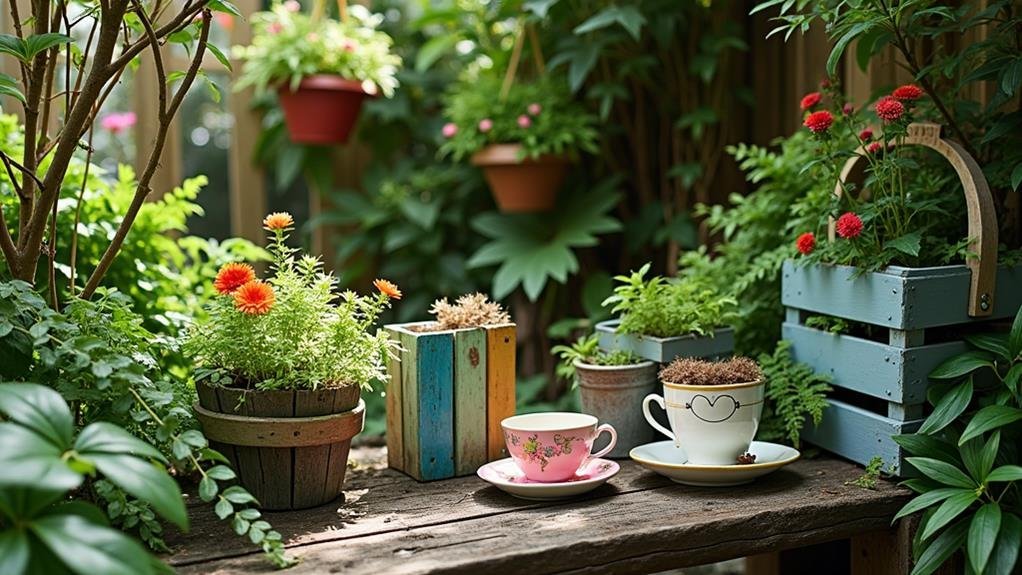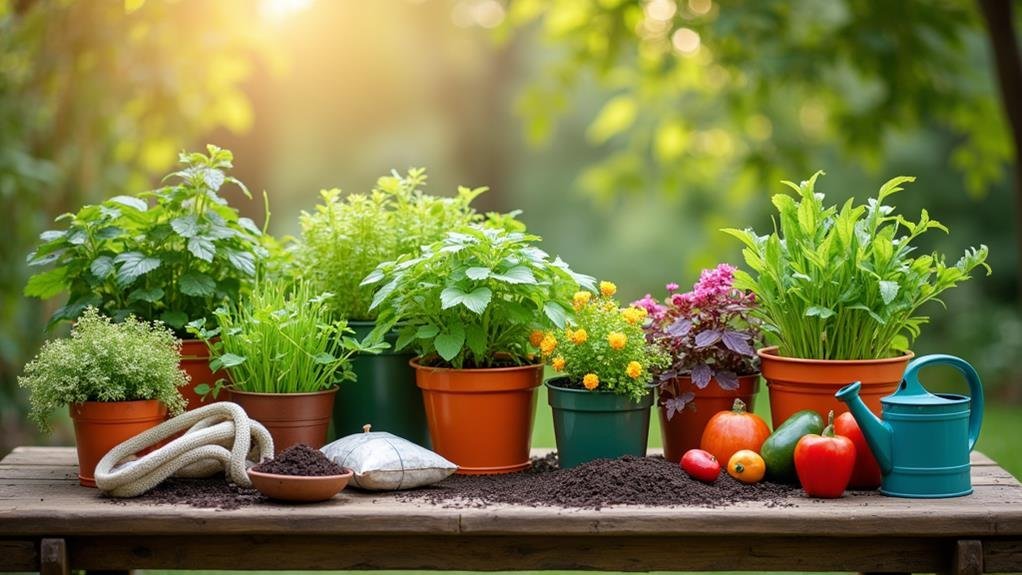If you've ever struggled to grow plants in shady areas, you might want to contemplate container gardening as a solution. This approach not only lets you position your plants for maximum light but also allows you to tailor the soil conditions to suit specific needs. Plus, it can greatly reduce maintenance while enhancing the visual appeal of those often overlooked spots in your yard. Curious about which plants thrive in shade or how to design your containers for impact? There's much more to investigate.
Benefits of Container Gardening

Embracing container gardening opens up a world of possibilities, especially in those tricky shady spots. One of the key benefits is flexibility. You can easily move containers around to find the perfect balance of light and shade, adapting to seasonal changes and varying sunlight. This means you're not limited to the fixed planting areas of your garden.
Another advantage is the ability to control soil quality. With containers, you can customize the potting mix to suit the specific needs of your plants, ensuring they thrive even in less-than-ideal conditions. You'll also reduce the risk of soil-borne pests and diseases, as the plants live in their own contained environments.
Container gardening also requires less maintenance compared to traditional gardening. You can manage weeds more effectively and have better control over watering. Plus, it allows for easier access; you can tend to your plants without bending down or stretching too far.
Lastly, container gardening can improve your outdoor space's aesthetic appeal. You can create a visually engaging display with various shapes, colors, and sizes, transforming those shady corners into inviting areas.
Best Plants for Shade
In regard to choosing the best plants for shady spots, you'll find a variety of options that thrive in low light conditions. Hostas are a popular choice, boasting lush foliage that comes in various shades of green, blue, and even variegated patterns. They're low-maintenance and can fill a container beautifully.
Another excellent option is ferns, which add a delicate texture and a touch of elegance to your garden. Consider the Japanese painted fern or the maidenhair fern for stunning visual interest.
If you're looking for flowering plants, consider begonias or impatiens. Both bloom vibrantly even in partial shade, bringing color and life to your containers. Heuchera, or coral bells, is another fantastic option, offering colorful foliage and tiny flowers that attract pollinators.
Don't forget about the creeping jenny, which spills over the edges of containers with its bright yellow-green leaves.
Ultimately, for a unique touch, try using a shade-tolerant ornamental grass like carex. With these options, you'll create a lush and inviting garden in those tricky shady spots, ensuring your outdoor space is vibrant and full of life.
Creative Container Ideas

A variety of creative container ideas can transform your shady spots into vibrant focal points. First, consider using unconventional containers like wooden crates or old wheelbarrows. These rustic options add character and can be painted or stained to match your style.
Don't shy away from vertical gardening; stacking pots or using tiered plant stands maximizes space and draws the eye upward. For a splash of color, you might try hanging planters. They're perfect for trailing plants, creating visual interest without taking up ground space.
If you have a small space, think about using a single large container filled with a mix of shade-loving plants—this creates a lush look without needing multiple pots. Repurposing items like teacups or tin cans can also bring a fanciful touch to your garden. Just verify they've proper drainage.
You can even use decorative stones or pebbles at the bottom of your containers to add texture and style. With these creative container ideas, you'll not only improve your shady areas but also express your personal flair. Your garden will surely become a charming retreat you'll love to share!
Soil and Drainage Tips
Choosing the right soil and ensuring proper drainage are essential to successful container gardening, especially in shaded areas. Start with a high-quality potting mix designed for container plants. This type of soil typically contains peat moss, perlite, and vermiculite, which provide vital nutrients and help retain moisture without becoming soggy.
For shady spots, you might want to add some organic matter, like compost, to your mix. This not only improves soil fertility but also boosts drainage, which is important to preventing root rot.
Remember, waterlogged soil can be detrimental, especially in low-light conditions.
When selecting pots, opt for those with drainage holes to allow excess water to escape. If you love decorative containers that lack drainage, consider using them as cachepots, placing your plant in a smaller pot with drainage inside the larger one.
Maintenance for Shady Gardens

Maintaining a shady garden requires diligence and attention to detail to guarantee your plants thrive in low-light conditions.
First, you'll want to keep a close eye on moisture levels. Shady areas can sometimes lead to overly damp soil, which can cause root rot. Make certain your pots have proper drainage and check the soil regularly, allowing it to dry out slightly between waterings.
Fertilizing is another vital aspect. Use a balanced, slow-release fertilizer suited for shade-loving plants; this guarantees they get the nutrients they need without overwhelming them. Remember to follow the recommended application rates to avoid burning your plants.
Pruning is essential, too. Regularly trim back any dead or overgrown foliage to promote airflow and light penetration. This helps prevent disease and keeps your plants healthy.
Finally, keep an eye out for pests and diseases. Shady gardens can sometimes harbor unwanted critters. If you spot any, address the issue promptly with appropriate treatments, whether that's organic solutions or targeted pesticides.
With consistent care and attention, your shady garden can flourish beautifully, showcasing a vibrant array of plants that thrive in those low-light spots.
Design Inspiration for Containers
When planning your container garden for those shady spots, consider how the design can enrich the area's natural beauty. Choose containers that complement your home and the surrounding landscape. For instance, rustic terracotta pots can add a warm, earthy feel, while sleek, modern planters might suit contemporary settings better.
Mix and match sizes and shapes to create visual interest. Tall containers can serve as focal points, while shorter ones can act as accents. Don't forget about color! Select hues that elevate your shady area, like vibrant greens and soft pastels, which can brighten up darker corners.
Consider using foliage plants that thrive in low light. Hostas, ferns, and shade-loving annuals can provide texture and depth. Layer your plants, placing taller ones in the back and shorter ones in front for a more dynamic look.
Lastly, don't shy away from adding decorative elements like garden stakes or fairy lights to create a fanciful atmosphere.
With these design inspirations, you'll transform your shady spots into beautiful, inviting spaces that you'll love to enjoy. Happy gardening!
Conclusion
Container gardening is a fantastic way to bring life to shady spots in your yard. By choosing the right plants and containers, you can create a beautiful, low-maintenance space that thrives in limited light. With proper soil and drainage, your plants will flourish, making it easy to enjoy a vibrant garden. So, roll up your sleeves, get creative, and transform those shaded areas into a stunning oasis that reflects your personal style!




